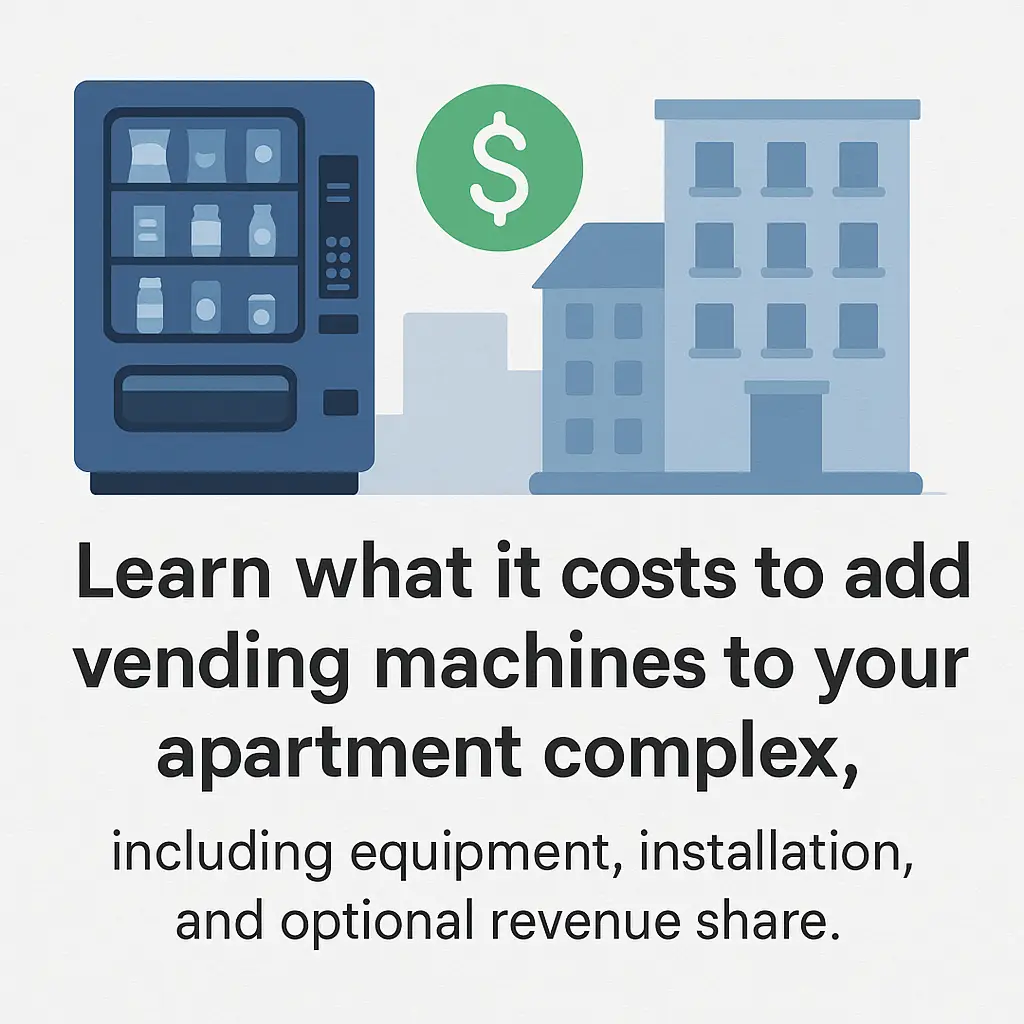Cost of Vending Services for Apartment Complexes
Learn what it costs to add vending machines to your apartment complex, including equipment, installation, and optional revenue share.
Back to Vending for Apartments ResourcesLearn what it costs to add vending machines to your apartment complex, including equipment, installation, and optional revenue share.
Back to Vending for Apartments ResourcesIn most cases, vending machine service for apartment complexes comes at no cost. Qualified buildings can receive free equipment, installation, and servicing—making it a no-risk amenity upgrade for residents.
![]() Most apartment vending setups require zero upfront investment
Most apartment vending setups require zero upfront investment
![]() Revenue share models can generate passive income for property managers
Revenue share models can generate passive income for property managers
![]() Vendors handle all service, restocking, and maintenance at no cost
Vendors handle all service, restocking, and maintenance at no cost

Adding vending machines to an apartment complex typically involves little to no direct cost for the property owner. In fact, most qualified buildings can receive machines with free installation, equipment, and replenishment. This makes vending a simple, hands-off amenity upgrade that can enhance resident satisfaction without stressing your property budget.
Operators generate revenue through sales of snacks, drinks, or shelf-stable items, and many provide optional revenue-share programs for property owners. Depending on your agreement, you can earn a percentage of monthly sales—as passive income—without managing the machines yourself. The standard share ranges between 5% to 20%, influenced by the location's foot traffic and product demand.
The machines themselves, whether combo vending setups or advanced glass-front or touchscreen models, are provided by local vending vendors. Most modern machines accept contactless payments and leverage smart monitoring technology for restocking alerts and real-time analytics. Vendors service them regularly to ensure they're stocked, clean, and functional. This means no property staff involvement is needed beyond providing power and selecting a placement area.
On average, setup can be completed in less than a week. Vendors assess your space, recommend the best machine type, and handle logistics. Equipment and electricity usage are generally minimal, especially when using modern energy-efficient vending systems. Some apartment complexes integrate AI smart coolers for a more innovative touch or higher-end offering.
Compared to other amenities, vending services offer a favorable cost-to-benefit ratio, especially for medium to large multifamily properties. Plus, vending options like healthy snacks, quick meals, and energy drinks serve as a convenient grab-and-go solution for residents.
To discover how vending setups compare in other facility types, see how warehouse breakrooms benefit too.
If you're exploring vending options for your business, Vending Exchange can help simplify the process. Delivery, Installation and Equipment is provided at no cost to you - vendors provide the machines, keep them stocked, and handle all servicing. Whether you need a provider or full-service management, just fill out the form on this page to get started.
In most cases, vending machines are provided and installed at no cost to the apartment complex. Vendors absorb these expenses and recover costs through product sales.
Operators earn revenue from the sale of snacks, drinks, and other products. Some also offer property owners a share of the vending profits.
Yes, many operators offer revenue share arrangements. Property managers can receive a percentage of the sales, typically ranging from 5% to 20%.
The vending operator is responsible for all maintenance, troubleshooting, and restocking. Property owners don’t have to manage the machines.
No. For qualified locations, all equipment, service, and installation are provided free of charge. Electricity usage is minimal.
Most vending setups can be completed within 7 days, depending on location and machine type.
Combo machines, glass-front vending machines, and AI coolers are all suitable for apartments depending on space available and resident preferences.
Yes, most modern machines accept contactless payment including tap cards, mobile wallets, and QR codes.
Common products include snacks, bottled water, energy drinks, healthy options, and shelf-stable meals.
Typically, the vendor and property owner collaborate to determine the best placement, ensuring convenience and electrical accessibility.